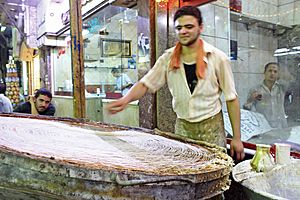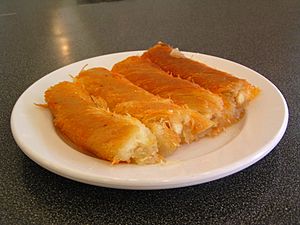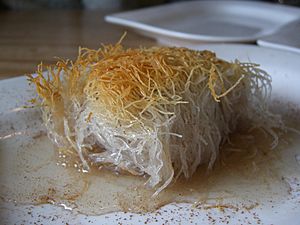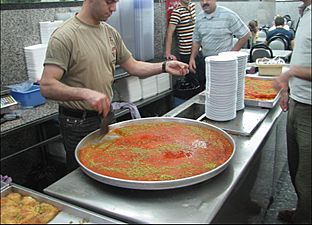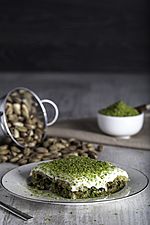Knafeh facts for kids
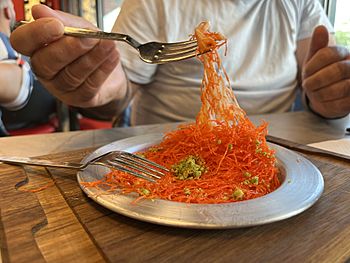
Cheese knafeh
|
|
| Alternative names |
|
|---|---|
| Type | Dessert |
| Place of origin | Middle East |
| Region or state | |
| Serving temperature | Hot |
| Main ingredients | |
| Variations | Multiple |
Knafeh (Arabic: كنافة) is a super yummy and traditional dessert from the Middle East. It's made with special thin pastry threads, like very fine noodles, called kataifi. This pastry is soaked in a sweet, sugary syrup called attar.
Usually, Knafeh has layers of cheese inside. But sometimes, people use other tasty things like clotted cream, pistachios, or other nuts. It all depends on where you are in the Middle East! You can also find different kinds of Knafeh in Turkey, Greece, and the Balkans.
In Arabic, the word Knafeh can mean the pastry threads themselves or the whole dessert. In Turkey, the pastry threads are called tel kadayıf, and the cheese dessert is called künefe. In Greece, it's known as kataifi.
One of the most famous types is knafeh Nabulsiyeh. This kind started in the city of Nablus and is a very important Palestinian dessert. Knafeh Nabulsiyeh uses a special white cheese called Nabulsi cheese. It's often cooked in a big round dish, and the pastry might be colored orange. Crushed pistachio nuts are usually sprinkled on top.
Contents
What's in a Name? The Story of Knafeh
The English word "Knafeh" comes from Arabic, mostly from places like Levant and Egyptian Arabic. You might see it spelled in many ways, like kanafeh, kenafeh, knafeh, or kunafa.
People aren't totally sure where the word kanafeh first came from. Some think it comes from an old Egyptian word, kenephiten, which meant a type of bread or cake. This idea comes from old Egyptian stories like One Thousand and One Nights.
Another idea is that it comes from an Arabic word, kanafa, which means "to flank or enclose." This might refer to how the pastry encloses the filling.
The Turkish word tel kadayıfı, which means "string-pancake," is thought to come from the Arabic word qatayif. This word means a pancake or crêpe.
A Sweet History: How Knafeh Came to Be
There's a fun story that Knafeh was first made to help caliphs (ancient rulers) feel full during Ramadan, a time when people fast during the day. Doctors supposedly suggested this sweet treat! This story might have happened in Egypt or Syria a long time ago. Some old writings from the tenth century also mention a dish that sounds like Knafeh.
However, the Knafeh we eat today might be a bit different from those old versions. For example, a cookbook from the tenth century called Kitab al-Tabikh (Book of Dishes) didn't mention the word kunāfa. But it did have recipes for desserts made with qatāyif, which are like crêpes. One recipe described qatāyif stuffed with nuts, fried, and covered in honey syrup. This sounds very similar to some modern desserts!
Later, in the 13th century, another cookbook from North Africa and Spain used the word kunāfa. It described a very thin crêpe, almost like a fine tissue. This book also had recipes for kunāfa layered with fresh cheese, baked, and topped with honey and rose syrup.
A big change happened in the Middle Ages. People found a new way to make the pastry: they dripped thin batter onto a metal sheet through tiny holes, creating hair-like strings! This new "string pastry" became the base for the Knafeh we know today. It was fried with butter and filled with sweet cheese or cream, then mixed with rosewater and sugar. This delicious dessert then spread from Arab lands to places like Iran, Greece, and Turkey.
How Knafeh is Made
There are a few different ways to make Knafeh pastry:
- Khishnah (Arabic: خشنة, rough): This uses long, thin noodle-like threads for the crust.
- Na'ama (Arabic: ناعمة, fine): This uses a dough made from semolina, which is a type of flour.
- Mhayara (Arabic: محيرة, mixed): This is a mix of both khishnah and na'ama styles.
- Mbrwma (Arabic: مبرومة, twined): This type is made by twisting the noodle threads.
To make Knafeh, the pastry is first heated in butter or a similar fat. Then, a layer of soft white cheese, like Nabulsi cheese, is spread on top. More pastry is added on top of the cheese. For khishnah kanafeh, the cheese is actually rolled up inside the pastry threads.
As it finishes cooking, a thick, sweet syrup is poured over the Knafeh. This syrup is made from sugar, water, and a few drops of rose water or orange blossom water. Sometimes, the top layer of pastry is colored red to make it look even more appealing. Finally, crushed pistachios are sprinkled on top for a beautiful garnish.
Different Kinds of Knafeh
Kanafeh Nabulsieh
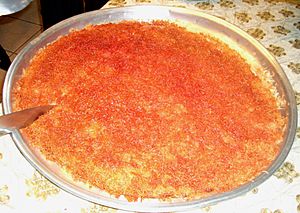
Kanafeh Nabulsieh comes from the Palestinian city of Nablus, which is why it has "Nabulsieh" in its name. Nablus is still very famous for its Knafeh. This version uses a mild white cheese and a shredded wheat surface, all covered in sweet sugar syrup. It's the most common type of Knafeh you'll find in the Middle East.
Kadayıf and Künefe
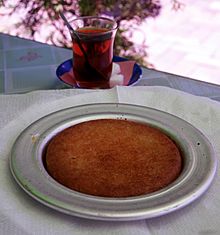
In the Hatay region of Turkey, this dessert is called künefe. The thin pastry threads are called tel kadayıf. A soft cheese, like Urfa peyniri or Hatay peyniri, is used for the filling. In künefe, the cheese is placed between two layers of the kadayıf threads, not rolled up. It's cooked in small copper plates and served very hot with syrup, clotted cream (called kaymak), and topped with pistachios or walnuts.
Riştə Xətayi
This special kind of Knafeh comes from Tabriz, Iran. Riştə xətayi is usually cooked during Ramadan in the world's biggest covered Bazaar of Tabriz. It's made with chopped walnuts, cinnamon, ginger, rose powder, sugar, rose water, and olive oil.
Kadaif
In Greece, this variant is called kataïfi or kadaïfi. The pastry threads are used to make different shapes, like tubes or little "birds' nests." These are often filled with chopped nuts, similar to another dessert called baklava.
Gaza Knafeh
This version started in the Gaza Strip, Palestine. It's made with soft bulgur (a type of cracked wheat), cinnamon, pecan nuts, and dairy fats.
World Records for Knafeh
Did you know there's a competition for the biggest Knafeh? In 2017, the world's largest plate of künefe was made in Antakya, Turkey. It was an amazing 78 meters long and weighed 1550 kilograms!
Before that, the city of Nablus tried to break the record in 2009 with a 75-meter tray that weighed 1,350 kilograms. However, neither of these attempts has been officially listed in the Guinness World Records. So, the title for the largest Knafeh is still up for grabs!
Gallery
-
Knafeh Nabulsieh
See also
 In Spanish: Kanafeh para niños
In Spanish: Kanafeh para niños


